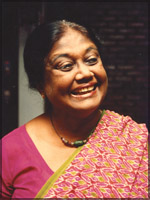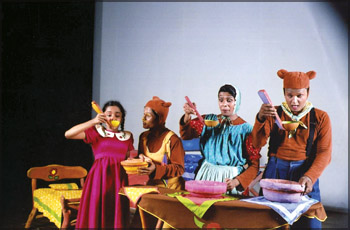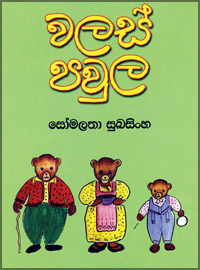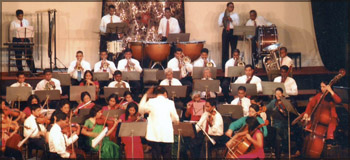Arts
Walas paula launched Peerless rendering
Educative endeavour in children’s theatre:
By Ranga Chandrarathne
[email protected]
However, since she seems to have forgotten certain points as a
social crusader who served generations, it is appropriate here to point
out some of them.
In the first place, the civilized society should not provide
platforms for publicity hunting self-proclaimed pundits without formal
education and who are solely dependent on their augmented images that
have been built through media and also maintained through media and
political influencing.
The civilized society has a responsibility not to allow crooks in
artist’s garb to exploit public platforms. If those crooks extolling
offshoot singers as ‘immensely gifted musicians’, the pertinent question
arises as what terms one may use to describe artists in the calibre of
Dr. Lionel Edirisinghe, Maestro Chitrasena, Dr. Lionel Algama, Dr.
Panibharata and P. V. Nandasiri Dr. Ameradeva, Somasiri Illesinghe etc.
Somalatha Subasinghe may provide an answer to this before she leaves for
France.
It is also pertinent to know the views that Somalatha Subasinghe who
made immense contribution to enrich Sri Lankan culture, holds on persons
who did not know the value of ‘Amude’ (loin cloth) and uses the term to
insult national figures who immensely contributed to culture. In a rich
culture like that of India will never allow insulting national figures
such as pioneering artists, statesmen and academics.
Why one should provide a platform for persons with sophisticated
ignorance who tries to impose bankrupt views such as there is no need to
follow traditions, fundamentals and theory in mastering a complex
subject like music. Somalatha Subasinghe may answer these questions
since she is engaged in community activities as an artist.
Walaspaula is one of the brilliant productions that comes from Lanka
Children and Youth Theatre Foundation (LCYTF). Creation of drama for
children is a difficult task.

It has been found out that the dramatist has to employ special
techniques to suit the children and the drama for children should also
be designed to develop children’s personality, perceptions and ideals.
The recent launch of the text of ‘Walas paula’ by veteran dramatist
and theatre personality Somalatha Subasinghe marks an important
milestone in Sri Lankan theatre for children. Walaspaula is based on
“The Three Bears and Goldilocks”. On many accounts, it stands out as a
major production.
Dr. Sunil Wijesiriwardena’s speech which dealt with transmission of
love from parents to children and artificial love for children which is
promoted through some advertisements was informative and thought
provoking. He pointed out that some advertisements promote artificial
love which is expressed in terms of feeding the child.
Somalatha Subasinghe through the drama and the text was able to step
into the children’s territory.
The sketch of big bear, medium and small bear and their chairs,
conveys a sense of family, help form perception in a child’s mind. It
should be mentioned here that sketches were wonderfully drawn appealing
to the child’s mind. Children’s world is tender and innocent and full of
wonders.
|

A Scene from ‘Walas paula’ |
So are the words and sketches in the ‘Walas paula’ text. The text is
designed using colours sparingly and big font size also helps children
to digest the text easily. Somalatha Subasinghe should be commended for
excellent production and text of Walaspaula which can also be considered
as children’s book.
‘Walas paula’ was marked for its economy of dramatic situations.
However, the most common feature of the text of the drama was that they
contained rhythmic dialogues and songs which would have been a daunting
task to translate it into aesthetically satisfying drama, especially
aimed at children’s audience.
In order to overcome these challenges, it seemed that directors have
exploited the intrinsic properties of songs and the well-defined
movements on the stage.
Distinctly songs appeal to the children’s audience which was
manifested by the high degree of attention the children paid to the
dramas from the very commencement to the end.
Through the production the director also attempted at creating
awareness in children of appreciating music, diverse colours and
rhythmic movements. The drama is designed to instill in children a
subconscious idea about the human relationships and hierarchical order
in a family; from father, mother, and brothers and to sisters.

It should be mentioned here that the music scores used for the drama
was drawn from a classical base in a manner representing diverse
traditions of music in Sri Lanka.
If the intention of the director was to introduce qualitative music
and Sri Lankan dance forms and culture to the children’s audience, it
will be successful as the music and dancing forms were well-integrated
into the drama so that they will register in the subconscious of
children.
This is, indeed, one of the effective methods in training children to
taste qualitative music and dance forms. Somalatha Subasinghe, Dr.
Chandanda Aluthge and Lanka Children and Youth Theatre Foundation (LCYTF)
which was established by Parliamentary Act of 3 of 2007, should be
commended for using drama as an effective tool of education, especially,
in the most appealing manner.
Tharupathy Munasinghe composed the music for ‘Walas puala’ .
Tharupathy is a young talented musician who amassed wealth of experience
in composing music for children’s drama.
Though children theatre is an effective tool of inculcating Sri
Lankan values and culture in children, Government’s attention has not
adequately been paid to this vital sector.
Soul of music with many colours
Young Soloists’ Concert 2008:
by Ranga CHANDRARATHNE
What struck me at the 51st session of Young Soloists’ concert 2008 by
Symphony Orchestra of Sri Lanka was sheer variety. It was this variety
in music which made each session of concert especial and unique.
Apart from introducing talents, this year’s concert was marked, among
other things, excellence in performance. One of the highlights of the
concert was Eshantha J Peiris’ “Perceived Historical Identity “premiered
at the concert.

In a way, Eshanhtha’s composition was an attempt to explore the
musical vocabulary of South Asia including traditional tone motifs of
Sri Lanka.
Here he had made a conscious effort to deviate from classical western
music approach with its defining techniques such as major scales and
triadic chord progression. It was a kind of a re-orientation of
traditional Sri Lankan tone motifs in an attempt to re-discover them
with a modern touch.
It seemed that he believed that creations could be made from the
existing traditions. However, his unrest attempt to re-discover Sri
Lankan legacy and sense of entitlement to local culture should not be
equated with putting old wine in new bottles. Instead it was like making
wine from Sri Lankan ingredients resulting in exotic new variety.
Perhaps, it was Eshantha’s penchant for adaptability and integration
of diverse traditions as affixing pearls on to a tapestry of tones that
resulted in the creation. Although this exercise can be defined as
fusion, Eshantha’s composition offered more than a mere fusion of
diverse traditions.
It was the fusion of the very souls of traditions. It was one of the
items which marked for its excellence in performance and composition.
Vinayak Rajendran who played W.A Mozart’s Piano Concerto no.23 in A
major on piano, was spell bounding. It stood out for Vinayak’s
versatility with the craft of playing the piano. This piece is very
important as it had been kept away from public for many years. Mozart
kept this piece as a personal treasure.
He composed the concerto in March 1786 while working on The Marriage
of Figaro. Here Vinayak played the concerto true to its original glory,
a rare feat in the contemporary arena of Sri Lankan music.
One of the significant aspects of his performance was that his
performance on piano, undoubtedly showed years of hard practice and
movements of the trained fingers on the board was outstanding as well as
the celestial score made them.
Looking at his many academic and extra curricular achievements, it
was not difficult to figure out the outstanding talents Vinayak
possesses. He had commenced his now brilliant career in music at the age
of four when he learnt piano lessons from Arundathi Gerard. Since then
he had not failed in his continuous quest for excellence.
Vinayak Rajendran was a brilliant performer at the Soloist Concert
and would linger in mind of those who had the luxury of watching it
live. It should be mentioned here that Vinayak had amply demonstrated
his unique talents in playing a complex concerto on piano.
All in all Young Soloists Concert marks a new dimension of music in
Sri Lankan arena of music and poise to enrich it in the years to come. |
